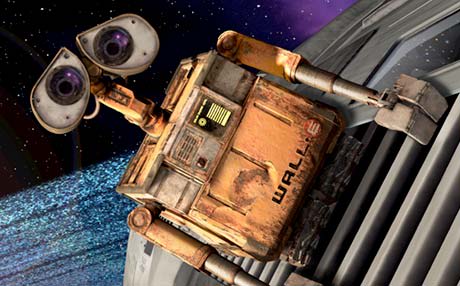The last robot on Earth is a tiny trash compactor, and after 700 years, hes developed a few personality quirks. He deciphers human detritus (a spork is particularly puzzling) and watches an ancient VHS tape of Hello Dolly!. Through this evidence, hes coming to the realisation that there should be someone else, something else for him to connect to.
That special robotic someone arrives in the form of EVE, a probe droid whom Wall-E follows back to her mother ship. Honouring the best traditions of sci-fi cinema, from Metropolis to Blade Runner (Sigourney Weaver voices the space vessels on-board computer in a nod to Aliens "Mother), whats surprising about this, one of the most accomplished films yet in Pixars arsenal, is the depth of its romantic soul.
Though Wall-E and EVE dont talk in traditional dialogue (Wall-E is voiced, R2D2-style, by the man who invented the blueprint: Ben Burtt), the pantomime of their romance is clear and true. Wall-E represents the big heart of Charlie Chaplins Little Tramp, while sleek, new EVE provides hope for the future amidst a backdrop of a planet destroyed by human consumption.
The pointed critique extends to the hyper-convenient life of Earths remaining humans (on vacation until the place gets cleaned up); the Axiom "cruise ship contains the films most eye-popping visuals and social critiques. Director Andrew Stanton has claimed to have no interest in a destroyed Earth back-story (Pixar already made that film it was 2006s Cars), and the in-space social world is pointed in its dystopia-by-comfort agenda.
But what separates Wall-E from an animated An Inconvenient Truth is the truth at Wall-Es robotic heart: its about love, stupid, and how we connect with one another. Through inanimate, animated robots, people might learn to put down the big gulp and talk to someone near them too.
(Pixar/Buena Vista)That special robotic someone arrives in the form of EVE, a probe droid whom Wall-E follows back to her mother ship. Honouring the best traditions of sci-fi cinema, from Metropolis to Blade Runner (Sigourney Weaver voices the space vessels on-board computer in a nod to Aliens "Mother), whats surprising about this, one of the most accomplished films yet in Pixars arsenal, is the depth of its romantic soul.
Though Wall-E and EVE dont talk in traditional dialogue (Wall-E is voiced, R2D2-style, by the man who invented the blueprint: Ben Burtt), the pantomime of their romance is clear and true. Wall-E represents the big heart of Charlie Chaplins Little Tramp, while sleek, new EVE provides hope for the future amidst a backdrop of a planet destroyed by human consumption.
The pointed critique extends to the hyper-convenient life of Earths remaining humans (on vacation until the place gets cleaned up); the Axiom "cruise ship contains the films most eye-popping visuals and social critiques. Director Andrew Stanton has claimed to have no interest in a destroyed Earth back-story (Pixar already made that film it was 2006s Cars), and the in-space social world is pointed in its dystopia-by-comfort agenda.
But what separates Wall-E from an animated An Inconvenient Truth is the truth at Wall-Es robotic heart: its about love, stupid, and how we connect with one another. Through inanimate, animated robots, people might learn to put down the big gulp and talk to someone near them too.
